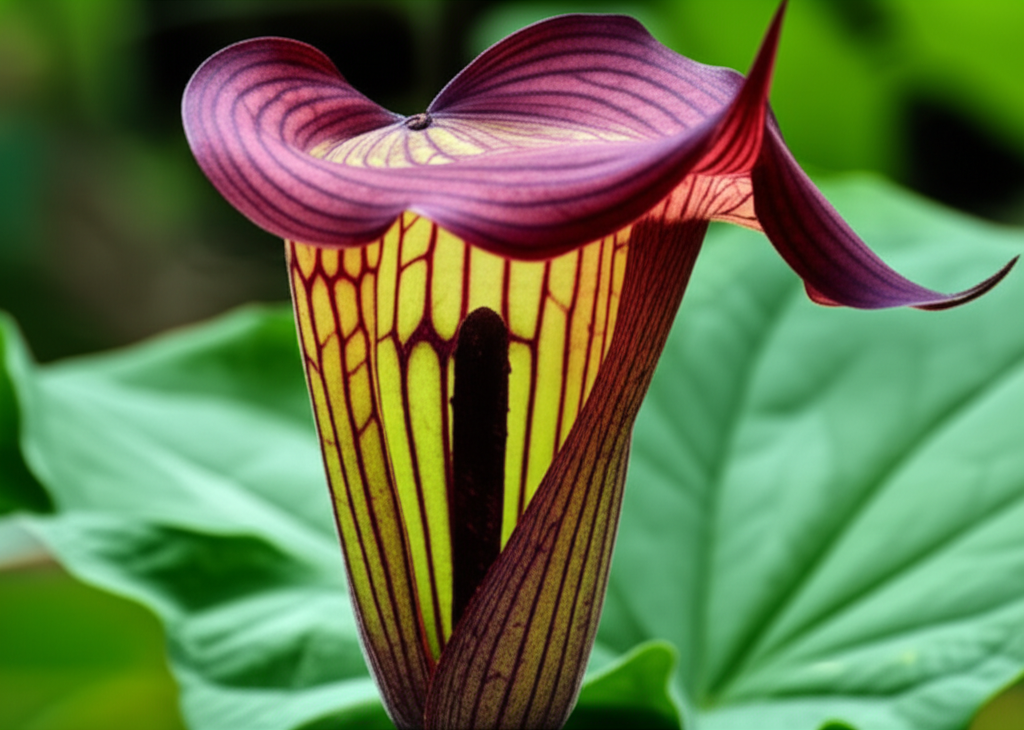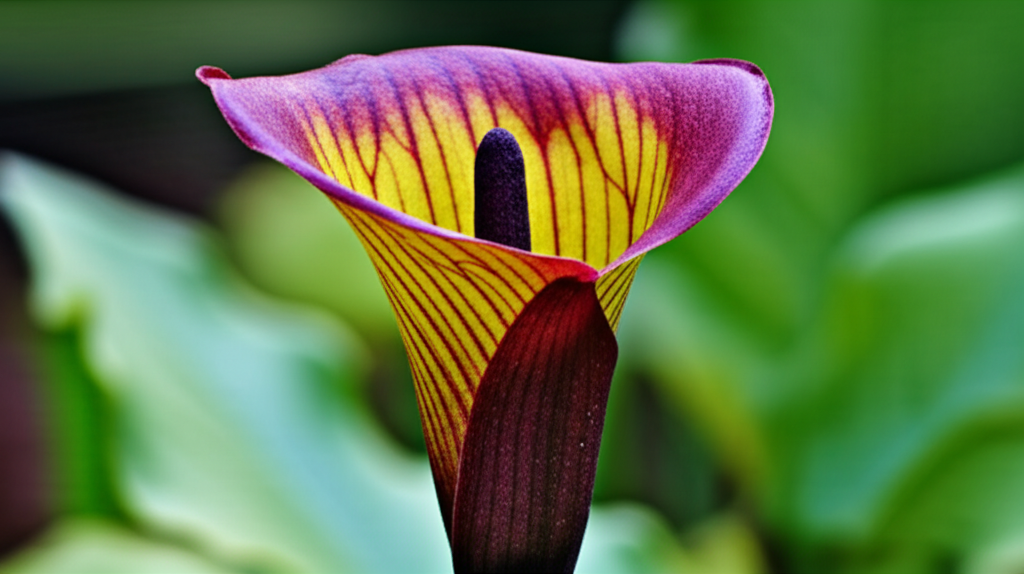The Allure of the Jack-in-the-Pulpit: A Forest Floor Gem
The Jack-in-the-Pulpit (Arisaema triphyllum) is a captivating native wildflower that enchants woodland enthusiasts with its unique and often surprising floral displays. Far from a conventional bloom, this perennial herb presents a spathe and spadix structure that evokes its namesake, a preacher within a pulpit. However, the true artistry of the Jack-in-the-Pulpit lies not just in its form, but in the intricate and varied combinations of color and texture that adorn its hooded spathe and fleshy spadix. This article delves deep into these fascinating aesthetic qualities, exploring the spectrum of hues and tactile sensations that make each Jack-in-the-Pulpit a miniature masterpiece of nature.
Understanding the Anatomy: Spathe and Spadix

Before appreciating the color and texture, it’s crucial to understand the components that create the Jack-in-the-Pulpit’s distinctive appearance. The plant typically features two to three trifoliate leaves, with the flowering stalk emerging from the center. The “flower” itself is actually a highly modified inflorescence consisting of:
- The Spathe: This is the large, hooded, leaf-like structure that encloses the spadix. It’s the most visually prominent part of the “flower” and exhibits the greatest variability in color and pattern.
- The Spadix: This is the fleshy, finger-like or club-shaped structure that rises from the base of the spathe. It bears the tiny true flowers and often terminates in a sterile appendage. Its color and texture are generally more consistent within a species but can still offer subtle variations.
The interplay between the spathe and spadix, their shapes, colors, and surface textures, creates the mesmerizing combinations that make each Jack-in-the-Pulpit so unique.
The Spectrum of Spathe Colors: A Palette of Nature’s Design
The spathe of the Jack-in-the-Pulpit is where the most dramatic color variations are observed. While often described as green, this is a vast oversimplification. The green can range from pale, almost lime-like hues to deep, emerald shades, and it is frequently overlaid or streaked with other pigments.
Greens: The Foundation of the Display
- Pale Green: Some Jack-in-the-Pulpits present a light, almost translucent green spathe, allowing for subtle undertones of other colors to peek through. This often gives them a delicate and airy appearance.
- Medium Green: This is perhaps the most common green hue, providing a neutral backdrop for the more striking markings.
- Dark Green/Olive Green: Deeper greens lend a more robust and grounded feel to the spathe, often appearing richer and more substantial.
The Intriguing Arrival of Purple and Maroon
Perhaps the most sought-after and striking coloration in Jack-in-the-Pulpits involves shades of purple and maroon. These colors can appear in various ways:
- Solid Purple/Maroon: In rare instances, the entire spathe can be a deep, velvety purple or a rich maroon. These specimens are particularly prized for their dramatic impact.
- Streaked Purple/Maroon: More commonly, purple or maroon appears as distinct streaks, veins, or blotches against a green or whitish background. These streaks can be fine and delicate or bold and broad.
- Marginal Purple: Sometimes, the purple coloration is concentrated along the edges or the opening of the spathe, creating a striking contrast with the interior.
- Interior Purple: The inside surface of the spathe can also be suffused with purple, creating a hidden, vibrant surprise when the spathe is lifted or partially open.
Subtle Shades: Whites, Browns, and Reds
Beyond greens and purples, other subtle colorations can contribute to the Jack-in-the-Pulpit’s visual appeal:
- Whitish/Creamy: Some spathes have a significant proportion of white or cream, often providing a canvas for darker venation. This can lend a more ethereal or ghostly quality to the bloom.
- Reddish Tones: While less common than purple, some individuals may exhibit subtle reddish or coppery hues, particularly on the exterior or along the margins.
- Brownish Undertones: In aged or certain environmental conditions, some spathes can develop brownish tinges, adding an earthy complexity.
The Texture of the Spathe: A Tactile Dimension
The surface texture of the spathe adds another layer of sensory appeal. While typically smooth, subtle variations can influence the overall impression:
- Glossy/Waxy: Many spathes possess a naturally glossy or waxy sheen, reflecting light and enhancing the vibrancy of their colors.
- Matte/Velvety: Other spathes have a more matte finish, which can make deeper colors appear richer and more profound, similar to velvet.
- Slightly Ridged: In some cases, the surface may exhibit very fine, almost imperceptible ridges, adding a subtle tactile quality.
- Pubescent (Hairy): While not common for the spathe itself, surrounding leaf structures or the base of the spathe can sometimes have fine hairs, contributing to a softer texture.
The Spadix: A Complementary Element of Color and Texture
The spadix, while smaller than the spathe, plays a crucial role in the Jack-in-the-Pulpit’s overall aesthetic. Its form, color, and texture provide a focal point within the hooded spathe.
Spadix Colors: From Pale to Deep
- Greenish-Yellow: Many spadixes have a base color of pale green or yellowish-green, especially at the base where the true flowers are located.
- Brownish-Purple: As the spadix matures or depending on the specific genotype, the upper portion, particularly the sterile appendage, can develop brown or purplish tones.
- Dull Yellow: Some spadixes present a more muted, dull yellow, offering a subtle contrast to the spathe.
Spadix Textures: Smooth to Club-Shaped
The texture of the spadix is generally smooth, but its shape and the density of the floral structures can create different impressions:
- Smooth and Slender: A smooth, almost polished spadix, often tapering to a point.
- Fleshy and Club-Shaped: A more robust spadix that swells towards the tip, resembling a club.
- Striated: The surface may appear finely striated due to the arrangement of the florets.
- “Bearded” Spadices: Some species or varieties can have a spadix that appears somewhat “bearded” due to longer, more prominent sterile structures at the tip.
Key Facts and Comparison of Jack-in-the-Pulpit Color and Texture
The variability in Jack-in-the-Pulpit coloration and texture makes direct comparison challenging, as it’s often dependent on local ecotypes and individual plant genetics. However, we can categorize some common combinations.
| Feature | Common Variations | Notes |
|---|---|---|
| Spathe Color | Green with Purple Streaking: The most prevalent and popular. | Streaks can be fine or broad, interior or exterior. |
| Solid Green: Simple and elegant. | Ranging from pale lime to deep emerald. | |
| White/Cream with Dark Venation: Ethereal and striking. | Often contrasted with dark purple or black veins. | |
| Spathe Texture | Glossy/Waxy: Enhances color vibrancy. | Common across many variations. |
| Matte/Velvety: Deepens color saturation. | Can give a richer, more subdued appearance. | |
| Spadix Color | Greenish-Yellow to Brownish-Purple: Typical progression. | Tip often darker than the base. |
| Dull Yellow: Muted contrast. | Provides a subtle focal point. | |
| Spadix Texture | Smooth and Tapered: Classic form. | Easy to identify. |
| Fleshy and Club-Shaped: More prominent. | Can appear more substantial. |
Factors Influencing Color and Texture
Several factors can influence the specific color and texture of an individual Jack-in-the-Pulpit:
- Genetics: This is the primary driver of inherent color and pattern. Individual plants possess unique genetic codes that dictate their potential.
- Environmental Conditions: Sunlight exposure can play a role. Plants in shadier conditions might have lighter greens, while those with dappled sun might exhibit more intense purple pigmentation. Soil moisture and nutrient availability can also subtly affect overall plant health and coloration.
- Age of the Bloom: As the spathe and spadix mature, their colors can deepen or change. A newly emerged spathe might be paler than one that has been open for a few weeks.
- Geographic Location: Different ecotypes of Arisaema triphyllum can have distinct color preferences, leading to regional variations in the prevalence of certain hues and patterns.
Cultivating and Appreciating Jack-in-the-Pulpits
For gardeners interested in incorporating these unique plants into their landscapes, understanding their preferences is key. Jack-in-the-Pulpits thrive in:
- Shade to Part Shade: They prefer dappled sunlight or the filtered light of a woodland setting.
- Moist, Well-Drained Soil: Rich, organic soil is ideal.
- Consistent Moisture: They do not like to dry out completely.
When selecting Jack-in-the-Pulpits for cultivation, observe the foliage and the emerging spathes for hints of the potential color and texture. While not all plants will produce the dramatic purple streaks, even the green varieties are beautiful in their own right, showcasing the intricate form and subtle textural nuances.
Steps to Observe and Appreciate: A Guide for the Curious
Observing the intricate details of a Jack-in-the-Pulpit is a rewarding experience. Follow these steps to fully appreciate its color and texture combinations:
| Step | Action | What to Look For |
|---|---|---|
| 1 | Locate the Plant | Search in shaded, moist woodland areas during spring and early summer. |
| 2 | Examine the Spathe Exterior | Note the base color (green, white, etc.) and any markings, streaks, or blotches. Observe the texture – is it glossy or matte? |
| 3 | Look Inside the Spathe | Gently lift or peek into the spathe to see the interior color. It may be different from the exterior. |
| 4 | Observe the Spadix | Note its color and shape. Is it slender, club-shaped, or bearded? How does its texture appear? |
| 5 | Consider the Leaf Structure | While not part of the “flower,” the leaves’ health and color can indicate the plant’s overall vigor. |
| 6 | Compare with Other Individuals | If possible, compare multiple Jack-in-the-Pulpits in the same area to see the range of variation. |
Pros and Cons of Variety in Jack-in-the-Pulpit Appearance
The inherent variability in Jack-in-the-Pulpit color and texture presents both advantages and challenges for enthusiasts.
| Aspect | Pros | Cons |
|---|---|---|
| Color Variation (Purple/Maroon) | Highly Desirable: Purple-streaked or solid purple/maroon specimens are sought after by collectors and gardeners for their dramatic visual appeal. Adds significant interest to woodland gardens. | Unpredictability: It can be difficult to guarantee specific color outcomes when purchasing seeds or even divisions, as genetics play a strong role. Not all plants will be strikingly colored. |
| Green Variations | Subtle Beauty: Even purely green specimens are elegant and possess intricate venation that can be appreciated up close. Their uniform color can create a calming effect. | Less “Wow” Factor: May not be as immediately striking to those seeking dramatic floral displays compared to purple varieties. |
| Texture Differences | Tactile Engagement: Subtle differences in glossiness or matte finish add a sensory dimension to observation, making each plant feel unique. | Hard to Quantify: Texture is subjective and often subtle, making it difficult to describe or compare precisely without direct observation. |
| Spadix Form | Focal Point: The shape and color of the spadix complement the spathe, adding depth and complexity to the overall inflorescence. | Often Overlooked: The spadix can sometimes be overshadowed by the spathe, leading to its intricate details being missed. |
Conclusion: A Masterclass in Natural Artistry
The Jack-in-the-Pulpit is more than just a woodland curiosity; it is a testament to nature’s boundless creativity. The intricate dance of colors – from verdant greens to rich purples and subtle whites – combined with the varied textures of its spathe and spadix, creates a spectrum of visual and tactile experiences. Each plant is a unique masterpiece, a fleeting work of art that graces the forest floor each spring. By understanding the anatomy and appreciating the factors that influence its appearance, we can gain a deeper admiration for this enigmatic wildflower and its captivating symphony of color and texture. Whether you are a seasoned botanist or a casual observer, the Jack-in-the-Pulpit offers a captivating glimpse into the subtle yet profound artistry of the natural world.


